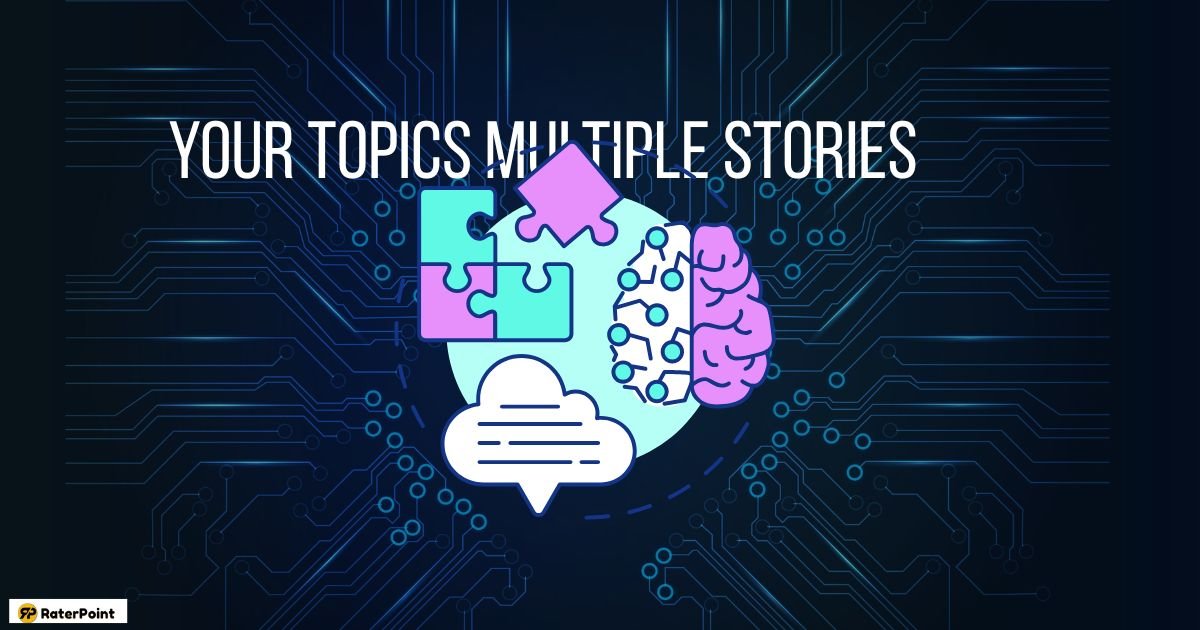Your Topics Multiple Stories: Top Tech 10 Ideas

Your Topics Multiple Stories – Meaning
Have you ever felt overwhelmed by the sheer variety of topics you’re passionate about? Or maybe you’ve struggled to find a way to tie multiple stories together seamlessly? “Your Topics Multiple Stories” is all about bringing your interests to life in a cohesive and engaging way.
By discovering connections between different ideas, we can create narratives that not only captivate but also inspire. Whether it’s blending technology with creativity or merging history with innovation, this approach empowers you to tell compelling stories that resonate with diverse audiences. Think of it as a way to turn your dynamic interests into a canvas filled with colorful perspectives.
With this, we give you the tools to explore, connect, and share your unique vision with the world.
Tech Perspective
The tech industry is evolving at an incredible pace, transforming the way we live, work, and communicate. With groundbreaking advancements happening every day, it can feel overwhelming to keep up. Storytelling plays a vital role in showcasing these innovations, shedding light on the challenges faced, and illustrating their impact on society.
This overview sets the stage for discussing the top 10 story ideas in the tech world—ideas that will help you understand cutting-edge developments, inspire thought-provoking conversations, and uncover the human side of technology.
What Is It Called When a Story Has Multiple Stories?
When a story incorporates multiple narratives or plotlines, it is often referred to as a multi-narrative or nested narrative structure. This storytelling technique involves weaving together different perspectives, story arcs, or characters’ experiences into a cohesive whole. Multi-narrative storytelling can appear in various forms, such as parallel plots, interwoven timelines, or stories within stories, depending on the creative vision of the author or storyteller.
This approach adds depth and complexity to a narrative, as it allows for the exploration of different viewpoints or themes simultaneously. It is frequently used in literature, film, and television to enhance engagement and provide a richer, layered experience for the audience. For instance, works like Cloud Atlas by David Mitchell or the film Pulp Fiction by Quentin Tarantino are prime examples of multi-narrative storytelling. These stories often challenge the audience to piece together connections between separate narratives, rewarding them with a comprehensive understanding of the overarching themes and relationships.
The Core Pillars of the Multi-Story Framework
| Pillar | Role in Storytelling | Key Aspect | Perspective Offered |
| Interconnected Narratives | Creates links between distinct stories to form a cohesive whole | Focuses on thematic and character connections | Encourages understanding of the bigger picture |
| Nonlinear Structure | Challenges traditional chronological storytelling methods | Introduces dynamic pacing and intrigue | Provides multiple entry points for the audience |
| Character Diversity | Highlights varied experiences and viewpoints | Expands on motivations and emotional depth | Offers a richer, more inclusive narrative |
| Symbolism and Themes | Reinforces central ideas that span across narratives | Unifies the smaller stories under shared meaning | Invites reflective interpretation from viewers |
| Audience Engagement | Actively involves the audience in piecing together the story | Promotes curiosity and critical thinking | Ensures active participation and investment |
This framework ensures that multi-story narratives remain engaging, complex, yet accessible, allowing creators to effectively explore themes, relationships, and broader ideas across their works.
Your Topics Multiple Stories: Top Tech 10 Ideas
1. The Rise of Artificial Intelligence
Numerous facets of daily life have undergone radical upheaval as a result of the exponential expansion of artificial intelligence (AI). Artificial Intelligence (AI) has merged smoothly into a wide range of businesses, from enhancing healthcare diagnostics and robotic-assisted surgeries to enabling better automation in industries and providing students with individualized educational aids.
However, in addition to its innovative uses, artificial intelligence has raised serious ethical questions, such as biases in machine learning systems and the possibility of its abuse for disinformation or monitoring.
As traditional jobs continue to be replaced by automation, discussions about the future of AI also raise questions about how this will affect employment. However, when AI is used carefully, technology has the potential to improve human productivity, creativity, and quality of life, paving the way for a future in which intelligent robots and humans work together.
2. The Journey of Startups to Tech Giants
There is an exciting startup tale behind every tech titan. Businesses like Amazon, Google, and Tesla had modest beginnings but were propelled by innovative founders and audacious concepts. Google transformed the way we obtain information, while Amazon started out as a small online bookshop and expanded into a major player in e-commerce and technology worldwide.
These businesses encountered several difficulties, including obtaining early capital, defeating rivals, and negotiating unstable markets.
The lessons they learned from their success—having the guts to try new things, focusing on the needs of the client, and never giving up on perfection—are priceless. Their experiences demonstrate the fortitude, flexibility, and inventiveness needed to transform lofty goals into transformative realities.
3. Breakthrough Innovations Transforming Healthcare
Technology has radically altered the healthcare industry, resulting in ground-breaking improvements in patient care and medical research. While wearable medical technology tracks vital signs and provides real-time health data, telemedicine enables patients to consult with doctors from the convenience of their homes.
AI-driven analysis and genetic technology are making personalized medicines more widely available. These developments improve healthcare services’ accessibility, accuracy, and speed. However, the integration of tech in healthcare also raises concerns about data privacy and equitable access. There is a great deal of opportunity to rethink the future of health and wellness through the continued cooperation between technologists and medical experts.
4. The Evolution of Smartphones

Smartphones are now an essential component of modern culture, having completely changed the way we live, work, and communicate. Since the first smartphones were released, these gadgets have undergone substantial development, adding cutting-edge features like AI-powered virtual assistants, biometric security, and high-resolution cameras.
The limits of mobile capabilities are being pushed further by innovations like 5G technology and foldable screens. Exciting advancements in smartphone technology are anticipated in the future, such as enhanced energy efficiency and deeper integration with augmented reality (AR).
Their significant contribution to enhancing accessibility and global connection solidifies the smartphone’s position as a key 21st-century technology.
5. Women Pioneers Leading the Tech Revolution
There are more and more trailblazing women in the tech sector who have made revolutionary contributions. Technology has advanced thanks in large part to the efforts of individuals like Ada Lovelace, Grace Hopper, and modern leaders like Reshma Saujani.
Notwithstanding advancements, there are still obstacles for women in the computer industry, ranging from prejudice to a lack of chances.
By encouraging girls and women to seek professions in STEM fields, programs like Girls Who Code and Women Who Tech are helping to close this gap. We are reminded of the value of diversity in promoting creativity and developing inclusive solutions by the inspiring tales of women in technology.
6. Cybersecurity in a Digitally Connected World
It is impossible to overestimate the significance of cybersecurity as our world grows more linked. Cyberattacks on people, companies, and governments are becoming more frequent, endangering infrastructure and private information.
Digital systems are being protected by cybersecurity innovations like blockchain technology and AI-based threat detection. However, as phishing and social engineering techniques are still widely used, user education is essential to averting breaches. Making cybersecurity a top priority guarantees the security and privacy of digital platforms, making the internet a safer place for all users.
Read More: Deep Offshore Technology | The Future of Marine and Energy Innovation
7. The Green Tech Movement
Innovation in addressing climate change has made green technology an essential sector. Electric vehicles (EVs) are revolutionizing the transportation industry, while renewable energy sources like solar panels and wind turbines are lowering dependency on fossil fuels.
This transformation is being led by clean energy startups and companies like Tesla. These days, discussions about sustainability in technology center on reducing the negative effects of production and use on the environment.
Green tech shows how ecological responsibility and innovation may work together to ensure a sustainable future.
8. The Metaverse and Virtual Reality
The metaverse, which combines the real and virtual worlds to create immersive experiences, has the potential to completely change how we interact. The metaverse opens up new opportunities in gaming, remote collaboration, education, and entertainment thanks to virtual reality (VR) and augmented reality (AR).
Innovation in this field is being driven by AR technologies like HoloLens and VR systems like Oculus. But issues like exorbitant prices, technological constraints, and guaranteeing accessibility for a range of demographics continue to be major obstacles.
The metaverse is a cutting-edge area that is revolutionizing how people perceive creativity and connection.
9. Tech Accessibility for Everyone
In order to empower those with disabilities and guarantee equitable access to innovation, inclusive technology is essential.
The accessibility gap is being closed with the aid of features like voice commands, screen readers, and Braille technology. With accessibility features built into their products, companies like Apple have established the benchmark.
Beyond goods, fostering an inclusive design culture highlights the importance of tech accessibility to society. In addition to being morally imperative, making sure that technology helps everyone encourages innovation that advances humankind as a whole.
Read More: What Is Alaya AI and How Does It Actually Work?
10. Space Exploration and Technology
From manned flights to satellites and rovers, technological advancements have opened up new avenues for space exploration. Our approach to space exploration is being transformed by businesses like SpaceX and cutting-edge technologies like robots and AI-optimized spaceships.
Significant accomplishments like the creation of reusable rockets and the Mars rover missions demonstrate humanity’s expanding influence beyond Earth.
Additionally, the last frontier is now more accessible than ever thanks to space exploration opening the door for commercial space flight. Space exploration continues to inspire new generations of scientists and innovators while exposing the limitless potential of the universe, even as technology advances humanity.
Conclusion
The tech industry encompasses a fascinating array of topics, from advancements in space exploration and artificial intelligence to innovations in renewable energy and communication systems. Storytelling plays a crucial role in sharing these developments, inspiring curiosity, and making complex ideas accessible to everyone. By exploring the inventive and dynamic world of technology, we can better understand its impact and become part of shaping a more innovative future.
Also Read: App Development for Startups with Garage2Global Support
FAQs
What are the major trends in technology today?
Major trends in technology include the rise of artificial intelligence and machine learning, the expansion of renewable energy solutions, advancements in biotech, and the development of quantum computing. Additionally, technologies like blockchain and 5G networks continue to transform various industries.
How does storytelling influence technological advancements?
Storytelling bridges the gap between complex innovations and public understanding, making technology accessible to a broader audience. It fosters curiosity, inspires collaboration, and drives adoption by highlighting the real-world applications and significance of technological breakthroughs.
Why is it important to stay updated with technological developments?
Staying updated helps individuals and businesses adapt to changes, remain competitive, and take advantage of emerging opportunities. It also promotes informed decision-making and enhances our understanding of how technology shapes society.
What role does technology play in addressing global challenges?
Technology offers innovative solutions to challenges such as climate change, healthcare accessibility, and sustainable energy. Advances in technology enable efficient resource management, improved communication, and data-driven strategies to tackle critical issues affecting the planet.

